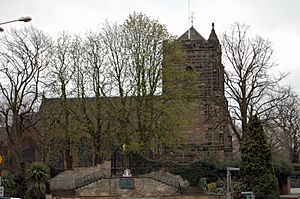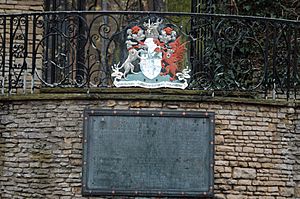Holy Trinity Church, Sutton Coldfield facts for kids
Quick facts for kids Holy Trinity Parish Church |
|
|---|---|

The church in April 2007
|
|
| 52°33′50″N 1°49′13″W / 52.563854°N 1.820148°W | |
| OS grid reference | SP1219096280 |
| Location | Sutton Coldfield, Birmingham |
| Country | England |
| Denomination | Church of England |
| History | |
| Founded | 15th century or before |
| Architecture | |
| Heritage designation | Grade I listed |
| Designated | 18 October 1949 |
The Holy Trinity Parish Church is a very old and important church in Sutton Coldfield, West Midlands, England. It is a Grade I listed building, which means it's considered a very special historical place. The area around it, called Sutton Trinity, even gets its name from the church!
Contents
A Look Back: The Church's History
People believe the first church on this spot was built way back in the 1200s. It was connected to the nearby Sutton Coldfield manor, which was like a big estate. The oldest part of the church you see today is the west tower, built in the late 1400s.
Changes Over the Centuries
In the 1530s, a famous person named Bishop John Vesey made the church much bigger. He added two side aisles, which are like extra hallways on the sides, and also put in an organ. Later, in the 1700s, more things were added, like galleries (balconies for people to sit), pews (church benches), and bells.
Inside the church, you can find the tomb of Bishop Vesey. There's also a special font (a basin for holy water) that was brought here in the 1800s from another church far away. The beautiful wooden screens and panels inside are very old, from the early 1600s. They were moved to Holy Trinity in 1875 from Worcester Cathedral.
In 1835, the church helped build a smaller chapel nearby. This chapel later became its own church, called St James' Church, Hill.
The Church Organ
Bishop Vesey gave an organ to the church in the 1530s. We don't know exactly what happened to it, but it probably disappeared during the English Civil War. A new organ was given in 1761.
Over the years, the church has had several organs. In 1829, a new one was installed. This was replaced in 1865 by a larger organ. Then, on April 3, 1900, a brand new organ was opened. It cost a lot of money back then! This organ was updated in 1921 and then replaced with another new one in 1950.
Organ Players
Many talented people have played the organ at Holy Trinity Church. One of the earliest known organists was John Alcock, who played from 1761 to 1786. He also played at other big churches. Later, George Halford played here from 1890 to 1891.
The Church Bells
The church tower has a set of 8 bells. Two of these bells are very old, from 1795. The other six bells were made in 1884 by a company called John Taylor and Co. The largest bell, called the tenor bell, weighs about 1189 kilograms (which is over 2,600 pounds!).
Holy Trinity Today
In the past, Holy Trinity Church was part of the mediaeval Diocese of Lichfield. Today, it is part of the Diocese of Birmingham.
In September 2013, a group called "Friends of Holy Trinity Parish Church" was started. Their goal is to raise money to help take care of the church. A local Member of Parliament, Andrew Mitchell MP, was their first special supporter. Their first big event was a concert in November 2013, hosted by a famous entertainer named Don Maclean.
Images for kids



